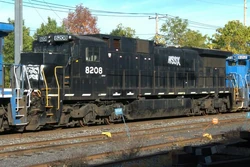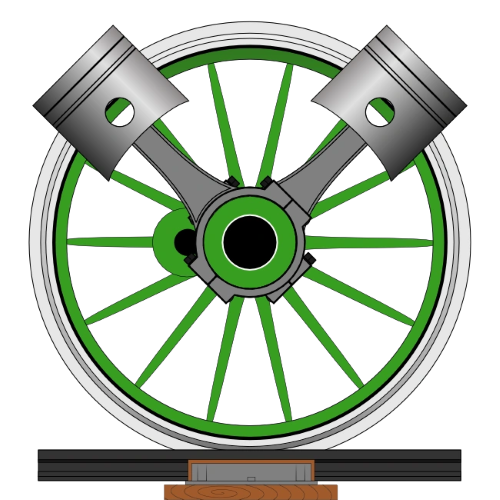
Former NS and Conrail C39-8 units as seen on the NHRS (New Hope Railroad System).
The GE C39-8 is a six-axle, 3,900 hp diesel locomotive built from 1984 to 1987 with a total of 161 (including a coal-powered prototype) built.
Conrail and Norfolk Southern were the only two railroads who originally ordered the model, while later owners consist of CSX (having a small fleet of former Conrail units), various leasing companies, as well as various foreign and shortline railroads.
They were commonly seen on both NS and Conrail (aside from after the Conrail purchase in 1999 by NS and CSX), yet have since become exceptionally rare since the units retirement beginning in 2004 and ending in 2008.
NS's fleet of C39-8E units were written off the roster. Aside from two, one of which in Storage the other, 8688 serving as the GE prime mover load test carbody in Altoona,PA.
History[]
The C39-8 (originally, yet unofficially designated as the "C39-S7") was the first type of six-axle diesel locomotive produced by GE since the C30-7 and C36-7 diesel locomotives from GE's "Dash 7" line. It was originally part of the "Super 7" experimental diesel locomotive series, which eventually became a rebuild program for older types of high-horsepowered diesel locomotives (similar to how EMD's MP15 and GP15 rebuilt locomotive lines developed after the SD45T-2 and SD40T-2's introductions). Although it had a classic design, it actually supported or featured some of the very first ever high-tech microprocessor technology to be added to a North American freight diesel locomotive, yet its successor; the C40-8, became even far more advanced and proved to be more successful shortly after the C39-8's introduction.
Although the actual locomotive proved to be reliable, it unfortunately wasn't built to last nearly as long compared to most EMD diesel locomotives (as with the rest of GE's diesel locomotives; which are often proven to not last nearly as long, but to simply serve their purpose being known as "conventional power"), aside from not becoming popular with most railroads other than sparking interests from Norfolk Southern and Conrail to use such units on their long, heavy-duty coal trains or coal drag service (besides using their3,200hp counter-parts for ballast and other mineral service).
The C39-8 lasted on Conrail until 1999, due to the Conrail Split by CSX and NS; while CSX used their fleet of former Conrail units until 2005, when they were scrapped or sold to various leasing, rebuilding, and shortline companies. NS, however; retired their original fleets of units from 2005 to 2007, but kept the C39-8E's in service until 2009 when these units were stored and later scrapped as well with only two C39-8E's survivng.
All of the original C39-8 units currently remain in service on various shortline, leasing, and rebuilding companies, most notably NREX and the Pennsylvania Northeastern shortline (subsidiary of the New Hope And Ivyland Railroad), while some were exported to Central America. As of 2021, PN 8212 is currently the last operational C39-8 in North America.
Flaws[]
Although a successful type of locomotive, the C39-8 experienced numerous flaws with the prime mover (engine or motor), turbocharger, and the overall cab design.
The turbocharger and engine often experienced numerous "teething" issues; to whom the engine either failed to function properly, or the turbocharger shut down due to overheating. (Although the cooling system was usually responsible for such issues.)
The cab; however, was often disliked by most employees due to being a "nuisance" because of how much it often tended to rattle or made the actual cab view from the main windows seem much lower to the ground, making rides uncomfortable (like with the EMD GP60M). These issues were eventually resolved, when GE began to add special insulators and rebuild the hood and carbody sections of the cabs to make the cab more porportionate with the rest of the locomotive. (Aside from eventually developing the C39-8E much later.)
The type of locomotive also wasn't very fuel efficient; therefore, it consumed quite a bit of fuel; thus causing pollution as well (10% more than GE's Evolution Series locomotives, which are proven to be fuel efficient and strictly follow the US EPA's "tier 2" policy.)
Trivia[]
- GECX #609 (originally GE #607; the C36-8 prototype) was converted to having a coal-sludge-powered engine during an experimentation project from 1992 to 1993 (known as a C39-8CF; the "CF" meaning, "Coal-Fueled").
- The project; however, was a failure. Thus, the unit was rebuilt to Dash 9 specifications and remained as a test unit designated as a "C39-9"; renumbered as GECX #899. GECX #609 was also actually involved during the development of the Dash 9, hence the unit's conversion into a C39-9.
- The coal-powered unit also began as an inspiration for GE to avoid using coal-powered engines (due to failures), but rather develop AC-traction technology; for AC-traction technology was in the process of being experimented with by EMD (their arch-rival) during the early-1990's, and was a step ahead of GE.
- NS received exactly 114 C39-8 of the original C39-8 units, with another order of 25 improved C39-8E ("Enhanced") units received shortly later. These "Enhanced" units had the "wedged" cab design used on the C40-8 (aside from the B39-8, B39-8E, B40-8, and B32-8E) as opposed to the original "hump-back" or "hunch-back" cab design, and were meant to be improved from the original model with having a better cab design which didn't suffer the same flaws as the original.
- The C39-8 was also one of the first types of new diesel locomotives to be purchased by NS after the merger was officially finalized in 1992.
- Conrail's fleet of C39-8 units (having only 22) lasted up until the split of the railroad in 1999; when it became purchased by CSX and Norfolk Southern, to which CSX acquired 9 of these units, with NS receiving the remaining 13.
- Only two of CSX's C39-8 units were repainted into their YN3 scheme, while the others either received their YN2 scheme, or simple patchwork.
- The FCCA (Ferrocarril Central Andino; a railroad or railway in the Latin American region) has a fleet of former Conrail units which still retain their original logos, only with a new paintscheme (each unit's scheme usually varies).
- Ironically, the railroad also experimented with converting some of their units into being gas-powered, primarily to reduce fuel consumption and air pollution.
